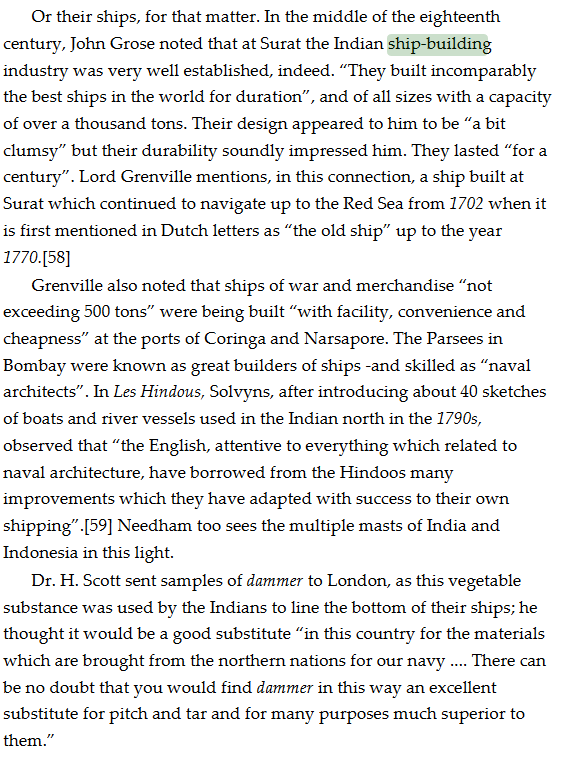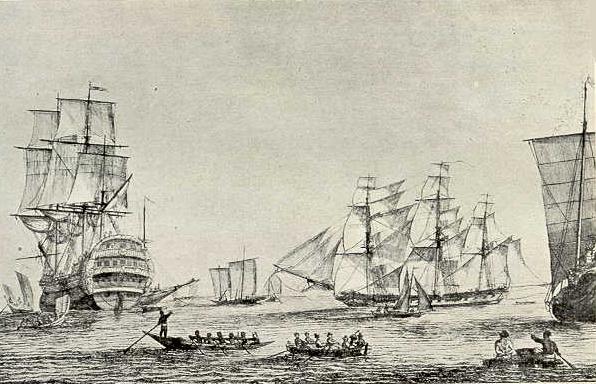Destruction of Indian shipbuilding industry is not known to many. Even Brits used to get ships manufactured for themselves before destroying it. https://twitter.com/joeagneya/status/1331644383171465216">https://twitter.com/joeagneya...
"In the middle of the 18th century, John Grose noted that at Surat the Indian ship-building industry was very well established, indeed, “They built incomparably the best ships in the world for duration”, and of all sizes with a capacity of over a thousand tons.
1/
1/
Their design appeared to him to be a “a bit clumsy” but their durability soundly impressed him. They lasted “for a century”.
2/
2/
Lord Grenville mentions, in this connection, a ship built in Surat which continued to navigate up the Red Sea from 1702 when it was first mentioned in Dutch letters as “the old ships” up to the year 1770.”
3/
3/
Grenville also noted that ships of war and merchandise “not exceeding 500 tons” were being built” with facility, convenience and cheapness” at the ports of Coringa and Narsapore.
4/
4/
Dr. H. Scott sent samples of dammer to London, as this vegetable substance was used by the Indians to line the bottom of their ships; he thought it would be a good substitute “in this country for the materials which are brought from the northern nations for our navy…
5/
5/
There can be no doubt that you would find dammer in this way an excellent substitute for pitch and tar and for many purposes much superior to them.”
6/
6/
Source:
"Decolonizing History: Technology and Culture in India, China and the West 1492 to the Present Day"
by Claude Alvares
https://www.amazon.com/Decolonizing-History-Technology-Culture-Present/dp/0945257406
7/7">https://www.amazon.com/Decoloniz...
"Decolonizing History: Technology and Culture in India, China and the West 1492 to the Present Day"
by Claude Alvares
https://www.amazon.com/Decolonizing-History-Technology-Culture-Present/dp/0945257406
7/7">https://www.amazon.com/Decoloniz...
I suggest that Internet Hindus and other Dharmic people on Sm to explore the following website. It& #39;s a mind blowing treasure trove of information on golden Hindu past, all referenced from mostly western sources. It& #39;s highly under utilized resource on web.
http://www.hinduwisdom.info/ ">https://www.hinduwisdom.info/">...
http://www.hinduwisdom.info/ ">https://www.hinduwisdom.info/">...
For example, I sourced abv tweet series from this page of the abv mentioned website.
http://www.hinduwisdom.info/Seafaring_in_Ancient_India.htm">https://www.hinduwisdom.info/Seafaring...
http://www.hinduwisdom.info/Seafaring_in_Ancient_India.htm">https://www.hinduwisdom.info/Seafaring...
It comes in book form too. An excellent gift item to cure someone of Gungadinism in your family and relationships. https://www.amazon.com/Tribute-Hinduism-Thoughts-Spanning-Continents/dp/B0013FYA52/ref=sr_1_1?ie=UTF8&s=books&qid=1215280718&sr=8-1">https://www.amazon.com/Tribute-H...
For example check out this piece of info on Catamarans and its modern uses.
"Indian Shipping: High Vessels - Pearl, fishers& #39; Grabs and Catamarans
(image source: From "Les Hindous" French early 19th century work).
http://www.hinduwisdom.info/Seafaring_in_Ancient_India.htm">https://www.hinduwisdom.info/Seafaring...
"Indian Shipping: High Vessels - Pearl, fishers& #39; Grabs and Catamarans
(image source: From "Les Hindous" French early 19th century work).
http://www.hinduwisdom.info/Seafaring_in_Ancient_India.htm">https://www.hinduwisdom.info/Seafaring...
"Francois Balazar Solvyns (1760-1824) a French maritime painter, wrote a book titled "Les Hindous" (tome troisieme) in 1811. He lived in Calcutta from 1791-1803 and he remarked:
"In ancient times, the Indians excelled in the art of constructing vessels, and the present Hindus can in this respect still offer models to Europe-so much so that the English, attentive to everything which relates to naval architecture, have borrowed from the Hindus
many improvement which they have adopted with success to their own shipping.... The Indian vessels unite elegance and utility and are models of patience and fine workmanship."
He has described some of the typical Indian vessels. A Pinnace or Yacht was a strongly masted ship, divided into two or three apartments, one for company, another for the beds, and a third as a cabinet, besides a place called varandah forwards for the servants.
Balesore, the principal entrance of the Hugli, is described as being frequented by different sort of vessels, and particularly by large ships from Bombay, Surat, and other parts of the western coast.
The vessels from the Ganges were called Schooners, which were very well fitted out and "able to make a voyage to Europe." their pilots being very skilful.
The Grab was a ship with three masts, a pointed prow, and a bowsprit, its crew consisting of a Nakhoda or captain and a few khelasses or sailors. The grabs were built at Bombay, their pointed prow signifying Hindu construction.
The Bangles were the largest Indian boats, some of them carrying four thousand or five thousand maunds of rice. Brigs were ships that came from the coast of Coromandel and Malabar, bringing to Calcutta the produce of those countries.
To the coast of Coromandel (Cholamandel) also belonged the Dhoni, with one mast, resembling a sloop. Its deck consisted of a few planks fastened on each side. It was badly rigged. Pattooas, lastly, were those ships that differed from other vessels by their being clincher-built;
"the boards are one upon the other, fastened by little pieces of iron in the form of cramps. The yard is always without sail, and the sails are hoisted and lowered by blocks."
Surprisingly, many earlier western traders and travelers have expressed the same views. Madapollum was a flourishing shipping center.
Thomas Bowrey, an English traveler who visited India during 1669-79, observes, "many English merchants and others have their ships and vessels yearly built (at Madapollum).
Here is the best and well grown timber in sufficient plenty, the best iron upon the coast, any sort of ironwork is ingeniously performed by the natives, as spikes, bolts, anchors, and the like.
Very expert master-builders there are several here, they build very well, and launch with as much discretion as I have seen in any part of the world. They have an excellent way of making shrouds, stays, or any other rigging for ships".
Alain Danielou (1907- 1994) son of French aristocracy, author of numerous books on philosophy, religion, history and arts of India has written:
"India& #39;s naval dockyards, which belonged to the state, were famous throughout history. The sailors were paid by the state, and the admiral of the fleet hired the ships and crew to tradesmen for transporting goods and passengers.
When the British annexed the country much later on, they utilized the Indian dockyards - which were much better organized then those in the West - to build most of the ships for the British navy, for as long as ships were made of wood."
In the days of the sailing ships and oaken vessels, the naval engineering of the Hindus was efficient and advanced enough to be drawn upon with confidence for European shipping.
At Madapollum, for example, on the Madras coast, many English merchants used to have their vessels yearly built. The Hindu ship architects could ingeniously perform all sorts of iron works, e. g., spikes, bolts, anchors, etc.
"Very expert master-builders there are several here," says the English traveler, Thomas Bowrey in his Geographical Account of Countries Round the Bay of Bengal (1669-1675); "they build very well, and launch with as much discretion as I have seen in any part of the world.
They have an excellent way of making shrouds, stays, or any other riggings for ship."
Writing even as late as 1789, on the eve of the Industrial Revolution in Europe, Solvyns, the French traveler, could still recommend, in his Les Hindous (Vol. III, 1811),
Writing even as late as 1789, on the eve of the Industrial Revolution in Europe, Solvyns, the French traveler, could still recommend, in his Les Hindous (Vol. III, 1811),
the Hindu method of uniting the planks are "not unworthy of the imitation of Europeans." He says, "In ancient times the Hindus excelled in the art of constructing vessels, and the present Hindus can in this respect still offer models to Europe."
In the building of the boat the Hindus began by choosing a large piece of timber which they bent as they pleased. To the two ends of this they attached another piece thicker than it, and covered this simple frame with planks;
"but they have a particular manner of joining these plants to each other, by flat cramps with two points which enter the boards to be joined, and use common nails only to join the plants to the knee.
For the sides of the boat they have pieces of wood which out pass the planks. This method is as solid as it is simple."
The Portuguese "imitated" the pointed prow in their Indian ships. This was a characteristic feature of the grab, a Hindu ship with three masts.
The industrial and material culture of Old India was thus sufficiently vital to influence contemporary Europe at the threshold of the 19th century civilization.
The tradition is reported also by old American sea-captains that fishing boats like the sloop, yawl, cutter, etc. so common in the United States waters were modeled in the & #39;"colonial period" on Hindu patterns.
(source: Creative India - By Benoy Kumar Sarkar p. 105).
(source: Creative India - By Benoy Kumar Sarkar p. 105).
Francois Balazar Solvyns (1760-1824) a French maritime painter, has made the following observation in his book, "Les Hindous"
Introducing the 40 or so sketches of boats and river vessels in use in Northern India in the 1790s,
Introducing the 40 or so sketches of boats and river vessels in use in Northern India in the 1790s,
he observes, "the English, attentive to everything which relates to naval architecture, have borrowed from the Hindoos many improvements which they have adapted with success to their own shipping."
Commenting on Indian rowing an early eighteenth century observer remarked: "Their water-men row after a different manner from ours. They move the oar with their feet, and their hands serve instead of the hypomochlion, or roller on which it turns."
(source: Indian Science and Technology in the Eighteenth Century: Some Contemporary European Accounts - By Dharampal Impex India. p.LVII).
From the teak forests, which were numerous along the western coasts, the Indians built their ships. Bishop Reginald Heber wrote in 1824, ships built by native artisans are notoriously as good as any which sail from London or Liverpool.
(source: Journey Through the Upper Provinces of India - Bishop Reginald Heber Vol. I and II p. 176).
U.S. adopts Indian Catamaran technology
Washington May 28 2003: The United States adopted ancient Indian catamaran-making technology to construct fast ships which were used with dramatic effect in the Iraq war, says a media report.
Washington May 28 2003: The United States adopted ancient Indian catamaran-making technology to construct fast ships which were used with dramatic effect in the Iraq war, says a media report.
Among the equipment the Americans used to win the Iraq war were 100-feet catamaran ships to ferry tanks and ammunition from Qatar to Kuwait.
The ships, built with technology adapted from ancient Tamil methods to make catamarans, can travel over 2,500 kms in less than 48 hours, twice the speed of the regular cargo ships, and carry enough equipment to support about 5,000 soldiers,
the Wall Street Journal reported yesterday.
Having a shallow draft, the boats can unload in rudimentary ports, allowing troops to land closer to the fight. — PTI
(source: U.S. adopts Indian Catamaran technology - http://hindu.com"> http://hindu.com and http://tribune.com"> http://tribune.com ).
Having a shallow draft, the boats can unload in rudimentary ports, allowing troops to land closer to the fight. — PTI
(source: U.S. adopts Indian Catamaran technology - http://hindu.com"> http://hindu.com and http://tribune.com"> http://tribune.com ).
A thread on the history of ship-building in India up to arrival of Brits. https://twitter.com/Hiranyareta/status/1331749861260206081?s=20">https://twitter.com/Hiranyare...

 Read on Twitter
Read on Twitter



